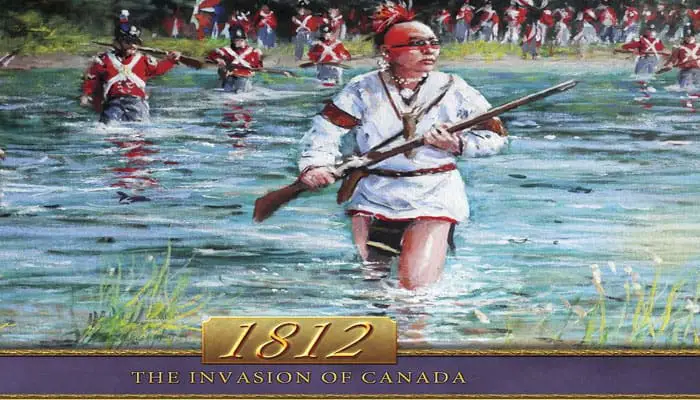

The year is 18 12. War is raging across Europe and Russia as Napoleon, emperor of France, seeks to dominate Europe through conquest. However, a coalition of France's enemies, led by Great Britain, desperately resists his ambitions.
Great Britain, in dire need of resources, is capturing American ships that are supplying France, confiscating their cargoes and impressing some of their sailors to serve in its Royal Navy.
The young United States objects. Eager to defend its sovereign rights and to strengthen its position in North America, the United States declares war on Britain on June 18, 1812.
Taking advantage of the British army's struggles against Napoleon in Europe, American forces invade Canada on July 12, 1812. The goal is to drive the British from their last remaining colony on North American soil. Surprised, Britain reels from the attack and now has to face another enemy threat on another continent.
Components

- 1 Map
- 60 Cards
- 25 red British Regular units
- 35 yellow Canadian Militia units
- 25 green Native American units
- 30 blue American Regular units
- 45 white American Militia units
- 1 Round Marker Pawn
- 20 Control Markers
- 13 Battle Dice
- 5 Turn Order Markers
Object of the Game
In 1812 - The Invasion of Canada, players take on the roles of the major factions that participated in the War of 1812. On the British side these are represented by the British Regulars (Redcoats), Canadian Militia and Native Americans.
The American Regular Army and American Militia comprise the American side. Players for each side will strategize together in order to plan and conduct their campaigns. Each side will attempt to capture Objective cities and forts on the map.
When a truce is called, the side that controls the most enemy Objectives wins.
Setup
-
Choose A Faction
Each player chooses a faction to play and takes the corresponding units, Battle Dice and cards of that specific faction's color.
Each faction is color coded as follows:
American Side:
- American Regulars - blue
- American Militia - white
British Side:
- British Regulars - red
- Canadian Militia - yellow
- Native Americans - green
When playing with fewer than five people, one or more players will control multiple factions on one side of the conflict. All factions must be played.
-
Map Setup
Place the map in the center of the table with American side players on the south edge and British side players on the north.
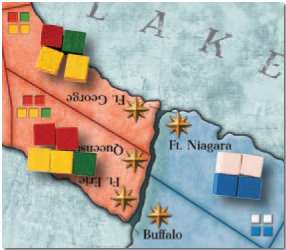
Homeland Areas - The map is divided into red and blue areas. Blue denotes American Homeland Areas and red denotes British Homeland Areas.
Objectives are starred cities or forts. The side controlling the most enemy Objectives at the end of the game wins.
Scenarios - This game contains three scenarios. An 1812 Introductory Scenario, the 1812 Full Campaign Scenario, and an 1813 Campaign Scenario.
-
Starting Units For The 1812 Scenarios
Some areas on the map have colored squares marked on them that represent the starting unit placements for the 1812 Introductory and 1812 Full Campaign Scenarios. Populate the map areas with the corresponding colored units.
-
Place Additional Units
The 1812 Scenarios require the players to place additional units. The number of units and where they are placed are listed in the scenario setup sections.
-
Unit Force Pools
Remaining units that were not placed on the map during the game setup are kept near each faction player. These units will be placed on the map during future rounds as Enlistments or as called for by Special Cards.
-
Draw Cards
Each scenario specifies which cards make up a player's draw deck at the beginning of the game. Players shuffle their decks and then each draws a hand of three cards from his deck.
If at any time a player holds only Special Cards, indicated by the word "Special" at the top of a card, he shows the cards, reshuffles them into his draw deck and draws three new cards. Players from the same side may show each other their cards in order to plan their future actions.
-
Place Round Marker
Place the Round Marker Pawn on space 1 of the round track located on the bottom left side of the map.
-
The Draw Bag
Place all Turn Order Markers in the Draw Bag. If playing the Full 1812 Campaign, draw the blue American Regulars Turn Order Marker and place it on the 1st Turn space.

Game Play
Rounds and Turns
The game is played over a variable number of rounds. During each round, all five factions will take a turn to mobilize units using movement cards.
The turn order is determined randomly. At the beginning of each round, all five Turn Order Markers are placed into the Draw Bag. A Turn Order Marker is blindly drawn from the bag and is placed on the '1st Turn' space of the turn track.
The color drawn denotes which faction's turn it is. The faction completes its turn before the next Turn Order Marker is drawn from the bag.
Note: The American Regulars always take the first turn of Round I in the Full 1812 Campaign.
Active Player
The person that controls the faction whose turn it is.
Once all the Turn Order Markers have been drawn and all the factions have had their turn, the round ends. All Turn Order Markers are returned to the Draw Bag and the Round Marker Pawn is advanced to the next round space.
The new round begins by drawing a new Turn Order Marker from the Draw Bag.
Game End Check
At the end of round 3 and at the end of each subsequent round, the end of game condition must be checked.
Game Turn
A drawn Turn Order Marker designates which faction takes its turn next. The active player can then perform the following actions in order:
- Place Enlistments & Fled Units in Muster Areas
- Play a Movement Card and up to Two Special Cards
- Resolve Battles
- Draw New Cards
1. Place Enlistments
Each faction has one or two Muster Areas on the map that show Enlistment cube graphics of their color.
- British Regulars - Montreal (3 red)
- Canadian Militia - Montreal (1 yellow), York (1 yellow)
- Native American - Six Nations (1 green) + 1 extra green
- American Regulars - Pittsburgh (2 blue), Albany (3 blue)
- American Militia - Pittsburgh (2 white), Albany (1 white)
Ex: Shown is the Albany area which is a Muster Area for American Militia and American Regular units.
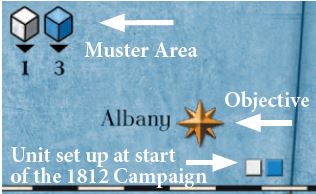
At the beginning of each of their turns, the active player pulls Enlistment Units from their Unit Force Pool and places them in their Muster Area(s). The number of Enlistment Units placed correspond to the number pictured below the cube graphic of their color.
Each faction has a limited supply of units in its Unit Force Pool. If a faction's Unit Force Pool has no units remaining, then no Enlistments can be placed that turn.
Native American Enlistments
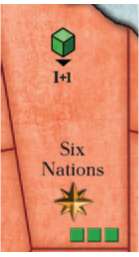
In addition to the 1 green unit placed on the Six Nations Muster Area, the Native American player may place an additional green unit in any other area already containing a Native American unit.
This additional unit can be placed in an American or British homeland area and it can be placed even if the Native American Muster Area is occupied by enemy units.
Place Fled Units
In addition to placing Enlistments, any of the active player's units located in the Fled Unit Space re-enter play by being placed in the active player's Muster Area(s).
Ex: It is the Canadian Militia's turn. The active player pulls yellow Enlistment units from the Unit Force Pool and places one in Montreal and another in York.
There are 7 yellow units in the Fled Units Space which the active player places in any quantity in Montreal and/or York. If enemy units occupy a Muster Area, no units may be placed on that area.
This could result in a turn without Enlistments or Fled Units being placed on the map. If this is the case, the active player loses that turn's Enlistments and their Fled Units stay on the Fled Units Space.
The active player now plays a Movement Card.
2. Play a Movement Card and Up to Two Special Cards
Each faction has a custom deck of twelve cards, eight of which are Movement Cards and four that are Special Cards. The active player must play one Movement Card on his turn. He may also play up to two Special Cards.
Units may be moved by land or water, depending on what the Movement Card allows. No more than one Movement Card may be played by the active player during his turn.
Remove from the game all played cards, except for Truce Movement Cards.
Land Movement Cards
Land Movement Cards allow units to move from one land area to the next. Units are moved by the active player as permitted by the Movement Card played and as modified by any Special Card played.
Armies
Armies are groups of units in the same area. An army can be made up of units from different allied factions.
Ex: A British army in an area could be comprised of 3 red British Regulars units, 5 yellow Canadian Militia units, and 3 green Native American units.
The number of soldier figures on a movement card represents the number of armies that may be moved, follo many areas each of these armies may move.
Any army, including any of its units, may not be moved twice in a turn.
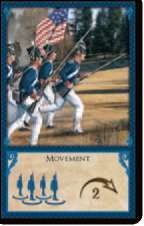
Ex: For the movement card shown, the American Regulars player may move up to four different armies two areas each. None of these armies or any of their units may be moved twice. (Some Special Cards grant an army added movement range).
In order to move an army, at least 1 unit in the army must belong to the active player. The active player can then move all units in the army including other allied units.
Ex: The American Regulars player could move an army comprised of 1 American Regulars unit and 6 American Militia units.
Armies are moved from area to area, across area boundaries. An army must stop if it enters an area occupied by enemy units. Armies cannot drop off or pick up units in the midst of movement.
An army may divide into multiple armies before moving. This allows the player to move an army while leaving another army behind. If the Movement Card allows multiple army movements, then the player may also move the other army to a different area. Multiple armies may move to the same area creating one large army.
Ex: There are 4 American Regulars and 5 American Militia units in Fort Niagara. It is the American Regulars' turn and the active player plays the movement card pictured above.
They first move 2 Regulars and 2 Militia into Fort George for one army move. Then they move 2 Regulars and 2 Militia into Queenston for a second army move. 1 Militia unit has not been moved and is left in Fort Niagara. The active player still has two army moves left.
The active player does not need to move the full amount of armies indicated on the movement card, nor use all the allowed movement per army.
A minor river is shown as a black line and can be crossed without a boat in the same manner as any map area border.
Truce Cards
Each faction has one Truce Card. Truce Cards are a type of Movement Card and are played as such. After having been played, they are lined up along the western edge of the map instead of being discarded.
This is so that players can track how many Truce Cards have been played. When the Truce Cards have been played by all factions of an alliance, at the end of the round the game ends.
Water Movement
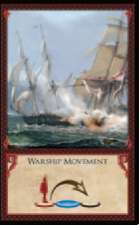
To cross a large body of water, a Warship, Fishing Boat or Canoe Movement card must be played.
Lakes and large rivers that are shown on the map as an aqua marine color are considered Large Bodies of Water. A large body of water ends where rivers are "greyed out".
Armies that have a Water Movement card may move from a land area adjoining a large body of water to any other land area adjoining the same large body of water, even if it is occupied by the enemy.
Ex: A British army in Prescott could move across Lake Ontario to Fort Niagara. This army could not move to Buffalo, which borders Lake Erie, because the two lakes are separated by a greyed out river.
Canoe and Fishing Boat Army Size Limits
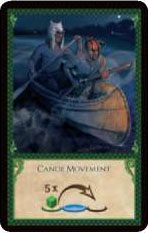
Some water movement cards limit the size of the armies that can be moved. The number of cubes and their colors denote the maximum units that may be moved per army.
Canoes allow 5 Native American units, from up to 5 different areas on the same body of water, to move to one single area on the same body of water.
Fishing Boats allow two armies, of up to 3 units each and from two different areas, to move to one single area on the same body of water.
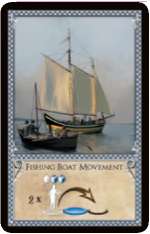
Ex: The American Militia Fishing Boat card allows two armies to be moved. Each army may contain up to 3 units and be composed of white and blue units, one of which must be white.
Out of Bounds Areas
Movement into the beige boundary territory is forbidden. Islands appearing in large bodies of water are not considered areas.
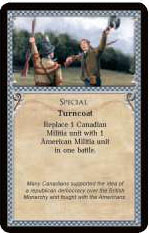
Special Cards
Each faction has unique Special Cards in its deck, indicated by the word "Special" at the top. These Special Cards modify movement or combat rules. When the active player plays his movement Card, he may also play up to all of the Special Cards in his hand.
After the Active Player has finished with all movement for the turn, battles are resolved.
Objectives
These are important cities or forts and are depicted with a star next to the city or fort name.
When a side controls an enemy Objective, control is tracked by placing a Control Marker on the area with the controlling side's flag symbol face up.
A side controls an enemy Objective if its units occupy the area at the end of a turn. If a controlling side's units leave or are forced out of an enemy Objective Area, its Control Marker is removed and control reverts back to the homeland owners.
Ex: British forces occupy Buffalo at the end of the Canadian Militia's turn. A British Control Marker is placed in this area.
The side that controls the most enemy Objectives at game end wins (4.0). This is easily determined by counting the number of Control Markers for each side on the map.
The Fort Erie and Queenston area has two Objectives in it. If the Americans control this area, two American Control Markers are placed on it.
3. Battles
A battle occurs when opposing armies occupy the same area. If there are multiple battles, the Active Player chooses the order in which the battles are resolved. Any Special Cards played, that may influence a battle, must be assigned prior to battle resolution.
The side in whose Homeland Area the battle takes place has the initiative and rolls first. In red areas the British players have the initiative and in blue areas the American players have the initiative, regardless of which army is the attacker or defender.
First the players of the side with initiative simultaneously roll their Battle Dice and apply the results. If units of both sides remain after the results are resolved, the other side's players simultaneously roll their Battle Dice and apply the results. The battle continues, alternating back and forth, until only one side remains in the area.
Each faction's controlling player will roll his Battle Dice and make decisions for his own units. The player rolls an amount of dice corresponding to the number of his units present in the battle. The maximum number of dice that may be rolled by the American Regulars and British Regulars players is two, while for the American Militia, Canadian Militia and Native American players the maximum is three.
Battle Dice Results - Each faction's Battle Dice have a unique combination of Hit, Flee and Blank Command Decision faces.
Hit
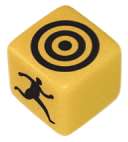
A Hit result causes an opponent's unit to be removed from the map and placed in its Unit Force Pool.
The opponents decide among themselves which unit to remove, if there is more than one faction to choose from.
Flee
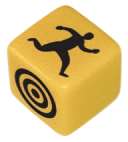
A Flee result causes a faction's own unit of the colored die rolled to flee the battle.
These units are placed in the Fled Units Space on the map. These Fled Units are returned to the owning faction's Muster Area(s) at the beginning of that faction's next turn.
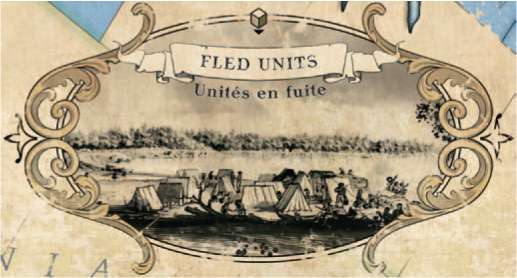
Command Decision
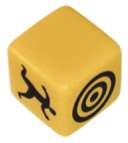
When a blank die face is rolled, the controlling player may decide to move one of his own units out of the current battle. This unit can move to any adjacent Friendly Area.
Friendly Areas are any of your side's Homeland Areas that are empty or contain allied units; or any enemy Homeland Areas that are occupied by allied units.
Your side's Homeland Areas that are solely occupied by enemy units are not considered to be friendly. An area that contains both friendly and enemy units (an upcoming battle) is considered friendly and may be moved into.
The order in which Command Decisions are carried out is determined by the involved allied players.
If there are no friendly areas adjacent to a battle, then movement out of the battle is not an option.
An army that moved into a battle by water may not move out by water with a Command Decision.
Native American Command Decision
Native American units have an advantage and may use a Command Decision to move into unoccupied enemy Homeland Areas, including unoccupied American Objective Areas.
4. Draw Cards
At the end of his turn, the active player draws his hand back up to 3 cards. If there are not enough cards left in the draw deck, play with what remains.
If a player draws and only has 3 Special Cards in his hand and no Movement Cards, the player must show his cards, reshuffle them back into his draw deck and draw 3 new cards. A player must always have one movement card in his hand after drawing.
The Active Player's turn is over and a new turn begins by drawing a new Turn Order Marker from the Draw Bag.
End of the Game
The game end condition is evaluated at the end of round 3 and at the end of each subsequent round.
The game ends if at the end of a round all Truce Cards of one or both sides have been played. There are 3 Truce Cards for the British allies or 2 for the American allies.
The game is won by the side with the most Control Markers on the map. Games can end in a tie.
Ex. The Americans control three British Objectives, so have 3 American Control Markers on the map.
The British control two American Objectives, so have 2 British Control Markers on the map. The Americans win by 1.
Continue Reading

